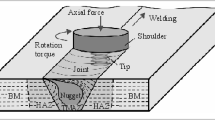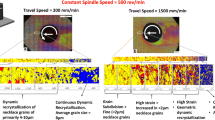The microstructure of welded joints obtained by friction stir welding (FSW) of structural steels and aluminum, copper and titanium alloys is studied. It is shown that the traditionally formed heat-affected zone is accompanied in the near-weld zone of FSW joints by a zone affected by thermal deformation (TDAZ) lying between the nugget and the HAZ. Two groups of alloys differing in the mechanism of plastic strain under FSW and affecting the formation of TDAZ and HAZ are distinguished.






Similar content being viewed by others
References
V. I. Pavlova, E. A. Alifirenko, and E. P. Osokin, “A study of temperature and time conditions of the welding heating, structure and properties of the metal of friction-stir-welded butt joints of an aluminum-magnesium alloy,” Vopr. Materialoved., No. 4, 74 – 88 (2009).
V. A. De Manvatkar, L. E. Svenson and T. Debroy, “Cooling rates and peak temperatures during friction stir welding of a high-carbon steel,” Scr. Mater., 94, 36 – 39 (2015).
R. Kaibyshev and S. Malopheyev, “Mechanisms of dynamic recrystallization in aluminum alloys,” Mater. Sci. Forum, 794 – 796, 7840789 (2014).
S. S. Malofeev and V. A. Kul’chitskii, “Structure and mechanical properties of friction-stir-welded joints of alloy 157°C,” Metally, No. 5, 94 – 99 (2012).
S. Yu. Mironov, Mechanisms of Plastic Deformation and Evolution of Microstructure in Friction Stir Treatment of Metals, Author’s Abstract of Candidate’s Thesis [in Russian], Ufa (2016), 26 p.
O. A. Kaibyshev, Superplasticity of Commercial Alloys [in Russian], Metallurgiya, Moscow (1984), 264 p.
V. N. Chuvil’deev, Nonequilibrium Grain Boundaries in Metals. Theory and Applications [in Russian], Fizmatlit, Moscow (2004), 304 p.
Yu. P. Kolobov, R. Z. Valiev, and G. P. Grabovetskaya, Grain Boundary Diffusion and Properties of Nanostructured Materials [in Russian], Nauka, Novosibirsk (2001), 213 p.
V. N. Chuvil’deev, M. Yu. Gryaznov, and V. I. Kopylov, “Grain boundary internal friction and superplasticity of nano- and macrocrystalline metals and alloys,” Metally, No. 5, 36 – 42 (2005).
A. A. Babareko, I. V. Égiz, and A. I. Khorev, “Superplasticity of titanium alloys of different classes,” Metalloved. Term. Obrab. Met., No. 6, 30 – 35 (1995).
E. F. Dudarev, G. P. Pochivalova, and Yu. R. Kolobov, “Microplastic deformation of submicrocrystalline titanium at room and elevated temperatures,” Izv. Vysh. Uchebn. Zaved., Fiz., 55(7), 88 – 96 (2012).
E. V. Nesterova and V. V. Rybin, “Mechanical twinning and fragmentation of commercially pure titanium in the stage of developed plastic strain,” Fiz. Met. Metalloved., 59(2), 396 – 406 (1985).
O. M. Smirnov, “Superplasticity of nanocrystalline and amorphous materials,” Perspekt. Mater., No. 10, 228 – 241 (2010).
A. V. Korznikov, G. F. Korznikova, and R. G. Zaripova, “Superplasticity of iron-base steels and alloys. A review,” Pis’ma Mater., 2, 170 – 176 (2012).
I. V. Moiseeva and V. K. Pishchak, “Deformation of iron and titanium in the temperature range of polymorphic transformation,” Fiz. Met. Metalloved., No. 5, 52 – 57 (2008).
M. S. Tikhonova, Recrystallization Processes in Austenitic Corrosion-Resistant Steel after High Plastic Deformations, Author’s Abstract of Candidate’s Thesis [in Russian], Belgorod (2015), 23 p.
O. A. Kaibyshev, Dynamic Recrystallization and Mechanisms of Plastic Strain in Magnesium Alloys and Steels, Author’s Abstract of Candidate’s Thesis [in Russian], Moscow (1995), 32 p.
O. P. Maksimkin, Stacking Faults, their Energy and Effect on the Properties of Irradiated Metals and Alloys [in Russian], Almaty (2010), 70 p.
Author information
Authors and Affiliations
Corresponding author
Additional information
Translated from Metallovedenie i Termicheskaya Obrabotka Metallov, No. 1, pp. 54 – 60, January, 2019.
Rights and permissions
About this article
Cite this article
Chularis, A.A., Rzaev, R.A. & Valisheva, A.G. Evolution of Mechanisms of Plastic Strain Responsible for Structure Formation in Near-Weld Zone Under Friction Stir Welding. Met Sci Heat Treat 61, 57–63 (2019). https://doi.org/10.1007/s11041-019-00376-4
Published:
Issue Date:
DOI: https://doi.org/10.1007/s11041-019-00376-4




